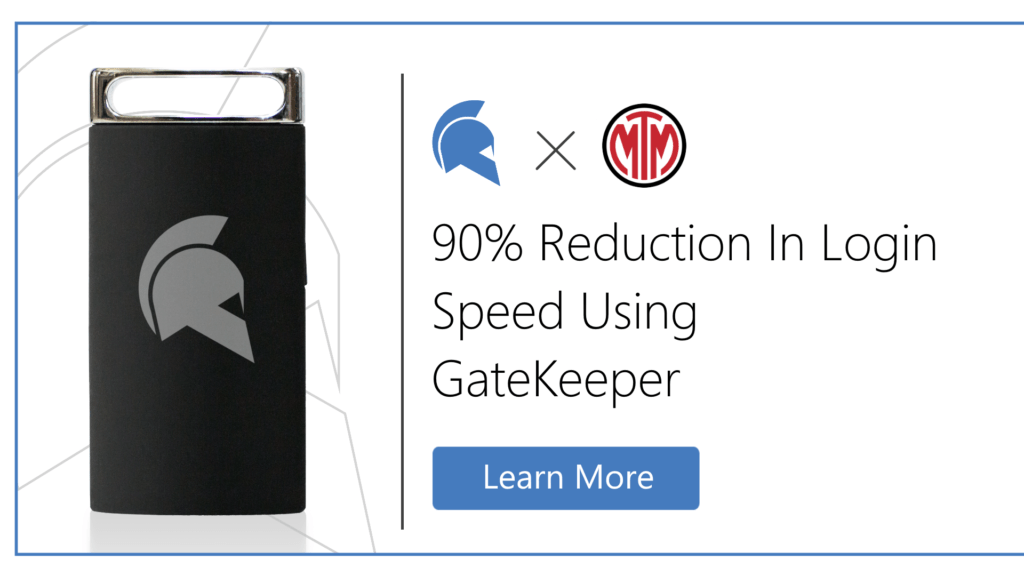
How Much Time can be Saved with Passwordless Login?
Saving time with passwordless login.
IT teams in all industries need to be able to support swift and secure logins. These logins must meet the operational needs of businesses while also achieving robust security. Passwordless login represents the next step in the evolution of this technology and can save businesses a huge amount of time and money in the process.
How does passwordless login save time?
Passwordless login is about more than just providing easy access to workstations. It is an effective tool for saving significant time across numerous operational aspects. Not using a password manager today is like trying to manage thousands of individual risk points all over the place without any way to map out all the permissions.
Preparing access credentials
Via a traditional password access system, users need to create a password and prepare other access credentials before they can start logging in. Most users will be familiar with this. The process is similar to signing up for a social media or email account, but with a key difference — the standard.
Regulatory bodies such as HIPAA and other industry-specific organizations place tight controls on data security, which means passwords and multi-factor authentication values must meet certain standards. Preparing passwords in accordance with these standards can be time-consuming, and the associated delays can be costly for businesses. Imagine taking weeks to get one new employee fully set up with access control and password-protected accounts due to an inefficient on-boarding process with no proper solutions for automation. What if you hire 100 people tomorrow? Let’s say each has 50 passwords – that’s a lot of manual work.
GateKeeper Enterprise utilizes automated password generation in accordance with regulatory standards. In turn, this eliminates the need for manual preparation of access credentials, saving time and money with every single login and logout event. Even with longer passwords, GateKeeper saves even more time – it’s like the Greek fire of password protection.
Managing and inputting passwords
After creating access credentials, users are responsible for maintaining them. This leads to several issues that increase time spent per login and put regulatory compliance at risk. If users need to create long and complex passwords in order to meet internal and external best practice standards, these passwords may become lost or forgotten, greatly increasing the average time per login.
Users will also be tempted to deploy simpler passwords or just reuse passwords. This makes password management easier, but it leaves businesses exposed to security risks. Naturally, much of this will boil down to employee habits, awareness, training, and motivations. Employees must know how to identify and avoid threats. They must also have good cyber security habits stemming from a motivation to sincerely protect. Without this motivation, weak passwords, reused passwords, passwords written down, and other insecure acts will be the chaos of the day.
Automated password generation reduces the compliance risk. The solution goes further, however, utilizing encryption to protect auto-generated passwords. Password management is no longer in the hands of the individual user, meaning there is no danger of the user forgetting their password. Forgotten and mismanaged passwords represent significant hazards for a business and its security policies — passwordless login removes these hazards while also saving valuable seconds and minutes.
Another extremely useful benefit of the GateKeeper password manager is secure zero-knowledge password sharing. Users can share passwords with others that need access to that account without sharing the password. To save even more time, if the password’s owner changes the password, there is no need to inform the others sharing that password since the password manager will automatically sync the password with all shared users. This also makes managing a mobile workforce’s passwords easier.
Transferring between users

In many business environments, users share workstations. As such, they must access these workstations quickly before locking the device to make it ready for the next user. Any points of friction begin to add up. This is especially true when extrapolated across large numbers of users and multiple workstations. Imagine managing thousands of users. Inevitably, there will be problems at some workstations with some end users. Reducing these incidents is key to reducing helpdesk tickets, costs, time spent on non-core tasks, and all manner of other inefficiencies.
Proximity access tokens make logging in simple and straightforward. When the user is in range, the computer prepares to authenticate. To complete the process, the user simply needs to input a personal identification number (PIN) – just like a debit card. This makes implementation and end user experience very easy.
The proximity-based system also works in reverse. The proximity token that will automatically lock the workstation once the token is out of range. The process begins again when a new user logs onto the system, creating a streamlined and reliable set of procedures from start to finish.
User onboarding and training
Bringing in and training new users is always an investment — both in terms of time and money. New users don’t know best practices right away. Instead, management will need to spend time and capital on equipping these users with the knowledge and tools they need to do their jobs in the right way. The longer this process takes, the more costly and a waste of productivity precious time.
Some level of delays and expenses are inevitable during onboarding. But large delays and high costs can be avoided with the right process and solutions. Passwordless access solutions help businesses to accelerate the onboarding process, bringing new users up to speed with only minimal delay and low cost. Instead of trying to communicate 100 passwords, just give the new employee a key.
This is because solutions like these are designed to be intuitive and highly user-friendly. New users are trained to use the solution in a fraction of the time it takes with traditional 2FA solutions. These users can quickly begin leveraging the very best from passwordless login procedures without delay. Time needed to onboard new users is much less. Overnight value realized.
User offboarding
As the organization grows, new users need to be onboarded. However, even with relatively low rates of turnover, departing employees need to be properly offboarded. Systems will be vulnerable without a proper offboarding process in place. Deprovisioning is a key area of security but one that is too often overlooked for other threats. Imagine a disgruntled employee that just got fired but still has access to web accounts.
The GateKeeper passwordless solution makes offboarding users seamless. A centralized management system underpins the solution’s access token and password generator. Business owners can track user access instances and identify anomalous logins. They can also quickly and effectively limit access clearance or remove it altogether. So, admins can instantly deprovision a leaving user and provision another.
Reducing help desk requests
If users are having trouble when logging in, this places significant strain on your help desk. This helpdesk needs to unlock workstations, retrieve passwords, generate new passwords, and handle any other login issues. When users need to manage and retain passwords themselves, they are more likely to have to call helpdesk. This is unnecessary downtime and a big cost on productivity.
GateKeeper’s proximity access fob, coupled with automatically generated time-based one-time passwords (TOTP), eliminates much of the burden for your help desk. This results in major time and cost savings. As your users find a more streamlined route to logging in, even over multiple login events.
Saving time by avoiding passwords.
How much time does this save exactly? While exact figures vary between different businesses and industries, our case studies highlight a common trend — significant time and cost savings across the year. The statistics below will give you some idea of how much you can expect to save.
- Moving from SMS or manual authentication has been shown to save thousands of working hours. GateKeeper utilizes autogenerated TOTPs, which are far more efficient.
- Passwordless access accelerated logins by 410% compared to manually typing and managing passwords.
- In the healthcare field, businesses have used the GateKeeper solution to save between 75 and 95 minutes per day and more than $19,000 per year.
- Another study of passwordless logins in the healthcare field found that each doctor was saving an amount of time equivalent to 50 traditional logins each day.
- Case studies show that instant two-factor authentication (2FA) can slash the number of help desk tickets generated. Some went from more than 16 per month down to two in some cases.
- Studies from the manufacturing industry found that GateKeeper’s passwordless 2FA solution led to a total monthly login time of around 20 hours for the entire facility! This represented a 90% reduction for the client, who had been spending 240 hours using traditional 2FA methods.
- On an individual level, time savings may seem small — perhaps only two to five seconds per login. However, extrapolate this across thousands of login instances and the savings really begin to grow. In the case of one client, 14,000 logins saved.
Learn more about how GateKeeper can benefit your business
Schedule a free consultation with the GateKeeper team and discover how GateKeeper’s passwordless solution works within the specifics of your own business. Save time by preventing password problems and helpdesk tickets.
See GateKeeper Enterprise advanced MFA in action.
Take a self-guided tour of how you can evolve from passwords. Then you're really saving time with automation.





